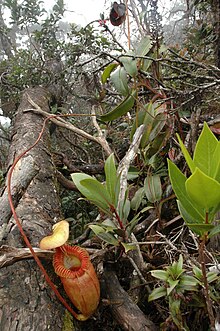Nepenthes villosa
| Nepenthes villosa | |
|---|---|

| |
| หม้อส่วนบนของ Nepenthes villosa จากเขากีนาบาลู | |
| สถานะการอนุรักษ์ | |
| การจำแนกชั้นทางวิทยาศาสตร์ | |
| โดเมน: | ยูแคริโอต |
| อาณาจักร: | พืช |
| เคลด: | พืชมีท่อลำเลียง |
| เคลด: | พืชดอก |
| เคลด: | พืชใบเลี้ยงคู่แท้ |
| อันดับ: | คาร์เนชัน |
| วงศ์: | หม้อข้าวหม้อแกงลิง |
| สกุล: | หม้อข้าวหม้อแกงลิง Hook.f. (1852) |
| สปีชีส์: | Nepenthes villosa |
| ชื่อทวินาม | |
| Nepenthes villosa Hook.f. (1852) | |
| ชื่อพ้อง | |
| |
Nepenthes villosa หรือ Villose Pitcher-Plant,[4] เป็นหม้อข้าวหม้อแกงลิงถิ่นเดียวของภูเขากีนาบาลูและภูเขาตัมบูยูกอน (Tambuyukon) ในตะวันออกเฉียงเหนือของบอร์เนียว เติบโตที่ความสูงสูงที่สุดมากกว่าหม้อข้าวหม้อแกงลิงทุกชนิดในบอร์เนียว ที่ความสูงมากกว่า 3200 ม. N. villosa มีลักษณะเพอริสโตมที่มีการวิวัฒนาการที่สูงและซับซ้อนมาก ซึ่งลักษณะเด่นนั้นคล้ายกับ N. edwardsiana และ N. macrophylla[5]
ชื่อ villosa มาจากภาษาละตินแปลว่า "เต็มไปด้วยขน" ซึ่งหมายถึงสิ่งปกคลุมที่มีอยู่หนาแน่นของหม้อข้าวหม้อแกงลิงชนิดนี้
ลักษณะทางพฤกษศาสตร์
[แก้]N. villosa สูงไม่เกิน 60 ซม.[4] ถึงแม้ว่าลำต้นอาจจะยาวถึง 8 ม.มีเส้นผ่าศูนย์กลาง 10 มม. ปล้องเป็นทรงกระบอกอาจยาวถึง 10 ซม.[5]
ใบคล้ายแผ่นหนังมีก้านใบ แผ่นใบรูปพายถึงรูปขอบขนานอาจยาวถึง 25 ซม. กว้าง 6 ซม. ปลายใบเว้าตื้น ก้านใบมีร่องเล็กตามยาว ยาวประมาณ 10 ซม. ปลอกหุ้มลำต้น เส้นใบปรากฏหนึ่งถึงสามเส้นในแต่ละด้านของเส้นกลางใบ สายดิ่งอาจยาวถึง 50 ซม.[5]

หม้อบนและหม้อล่างคล้ายกัน มีทรงรูปคนโทถึงรูปไข่ สูงประมาณ 25 ซม.[4] กว้าง 9 ซม. มีปีกคู่ตะเข็บ (กว้าง ≤15 มม.) อยู่ด้านหน้าของหม้อ ถึงแม้ว่าจะลดรูปลงเหลือแค่สันในหม้อบน ปากหม้อลาดเอียงและยกขึ้นในคอด้านหลัง ต่อมบนพื้นผิวภายในโค้งมีความหนาแน่น 200 ถึง 1300 ต่อมต่อตารางเซนติเมตร[3] เพอริสโตมเป็นทรงกระบอกเมื่อตัดขวาง กว้าง 20 มม. มีฟันหรือสันรอบเพอริสโตม ฝารูปหัวใจและมีจุดที่ปลาย มีเดือยเดี่ยว (ยาว ≤20 มม.) ที่ฐานของฝา[5]
N. villosa มีช่อดอกแบบช่อกระจะ ก้านช่อดอกอาจยาวถึง 40 ซม. ขณะที่แกนกลางยาว 20 ซม. ก้านดอกย่อยรูปเส้นด้าย-มีใบประดับย่อย ยาว 15 มม. กลีบเลี้ยงกลมถึงรูปไข่ ยาว 4 มม.[5][6]

N. villosa มีสิ่งปกคลุมหนานแน่น เป็นขนยาวสีน้ำตาล ปกคลุมทุกส่วนของพืช[5]
อ้างอิง
[แก้]- ↑ Clarke, C.M. (2018). "Nepenthes villosa". The IUCN Red List of Threatened Species. 2018: e.T39712A143966651. doi:10.2305/IUCN.UK.2018-1.RLTS.T39712A143966651.en.
- ↑ 2.0 2.1 Schlauer, J. N.d. Nepenthes villosa. Carnivorous Plant Database.
- ↑ 3.0 3.1 Danser, B.H. 1928. The Nepenthaceae of the Netherlands Indies. Bulletin de Jardin de Botanique, Buitenzorg, Série III, 9(3–4): 249–438.
- ↑ 4.0 4.1 4.2 Phillipps, A. & A. Lamb 1996. Pitcher-Plants of Borneo. Natural History Publications (Borneo), Kota Kinabalu.
- ↑ 5.0 5.1 5.2 5.3 5.4 5.5 Clarke, C.M. 1997. Nepenthes of Borneo. Natural History Publications (Borneo), Kota Kinabalu.
- ↑ Kaul, R.B. 1982. Floral and fruit morphology of Nepenthes lowii and N. villosa, montane carnivores of Borneo. American Journal of Botany 69(5): 793–803.
อ่านเพิ่ม
[แก้]- Adam, J.H., C.C. Wilcock & M.D. Swaine 1992. "The ecology and distribution of Bornean Nepenthes" (PDF). คลังข้อมูลเก่าเก็บจากแหล่งเดิม (PDF)เมื่อ 2011-07-22. Journal of Tropical Forest Science 5(1): 13–25.
- Adam, J.H. 1997. "Prey spectra of Bornean Nepenthes species (Nepenthaceae) in relation to their habitat" (PDF). Pertanika Journal of Tropical Agricultural Science 20(2–3): 121–134.
- Bauer, U.; Clemente, C. J.; Renner, T.; Federle, W. (2012). "Form follows function: Morphological diversification and alternative trapping strategies in carnivorous Nepenthes pitcher plants". Journal of Evolutionary Biology. 25 (1): 90–102. doi:10.1111/j.1420-9101.2011.02406.x. PMID 22023155. S2CID 33527070.
- Beaman, J.H. & C. Anderson 2004. The Plants of Mount Kinabalu: 5. Dicotyledon Families Magnoliaceae to Winteraceae. Natural History Publications (Borneo), Kota Kinabalu.
- Clarke, C.M. 2006. Introduction. In: Danser, B.H. The Nepenthaceae of the Netherlands Indies. Natural History Publications (Borneo), Kota Kinabalu. pp. 1–15.
- Clarke, C.; Moran, J.A. (2011). "Incorporating ecological context: A revised protocol for the preservation of Nepenthes pitcher plant specimens (Nepenthaceae)". Blumea - Biodiversity, Evolution and Biogeography of Plants. 56 (3): 225–228. doi:10.3767/000651911X605781.
- Clayton, C.H. 1995. Nepenthes villosa—the furry one. Bulletin of the Australian Carnivorous Plant Society, Inc. 14(4): 11–12.
- Corner, E.J.H. 1996. Pitcher-plants (Nepenthes). In: K.M. Wong & A. Phillipps (eds.) Kinabalu: Summit of Borneo. A Revised and Expanded Edition. The Sabah Society, Kota Kinabalu. pp. 115–121. ISBN 9679994740.
- Denton, B. 2001. Mt. Kinabalu - much more than Nepenthes utopia. Bulletin of the Australian Carnivorous Plant Society 20(3): 1–4.
- Dixon, W.E. 1889. Nepenthes. The Gardeners' Chronicle, series 3, 6(144): 354.
- Lecoufle, M. 1990. Nepenthes villosa. In: Carnivorous Plants: Care and Cultivation. Blandford, London. pp. 122–123.
- (ในภาษาอินโดนีเซีย) Mansur, M. 2001. "Koleksi Nepenthes di Herbarium Bogoriense: prospeknya sebagai tanaman hias" (PDF). คลังข้อมูลเก่าเก็บจากแหล่งเดิม (PDF)เมื่อ 2012-03-19. In: Prosiding Seminar Hari Cinta Puspa dan Satwa Nasional. Lembaga Ilmu Pengetahuan Indonesia, Bogor. pp. 244–253.
- Moore, D. 1872. On the culture of Nepenthes at Glasnevin. The Gardeners' Chronicle and Agricultural Gazette 1872(11): 359–360.
- Masters, M.T. 1872. The cultivated species of Nepenthes. The Gardeners' Chronicle and Agricultural Gazette 1872(16): 540–542.
- McPherson, S.R. & A. Robinson 2012. Field Guide to the Pitcher Plants of Borneo. Redfern Natural History Productions, Poole.
- Meimberg, H.; Wistuba, A.; Dittrich, P.; Heubl, G. (2001). "Molecular Phylogeny of Nepenthaceae Based on Cladistic Analysis of Plastid trnK Intron Sequence Data". Plant Biology. 3 (2): 164–175. doi:10.1055/s-2001-12897.
- (ในภาษาเยอรมัน) Meimberg, H. 2002. "Molekular-systematische Untersuchungen an den Familien Nepenthaceae und Ancistrocladaceae sowie verwandter Taxa aus der Unterklasse Caryophyllidae s. l." (PDF). Ph.D. thesis, Ludwig Maximilian University of Munich, Munich.
- Meimberg, H.; Heubl, G. (2006). "Introduction of a Nuclear Marker for Phylogenetic Analysis of Nepenthaceae". Plant Biology. 8 (6): 831–840. doi:10.1055/s-2006-924676. PMID 17203435.
- Meimberg, Harald; Thalhammer, Stefan; Brachmann, Andreas; Heubl, Günther (2006). "Comparative analysis of a translocated copy of the trnK intron in carnivorous family Nepenthaceae". Molecular Phylogenetics and Evolution. 39 (2): 478–490. doi:10.1016/j.ympev.2005.11.023. PMID 16414286.
- Mey, F.S. 2014. Joined lecture on carnivorous plants of Borneo with Stewart McPherson. Strange Fruits: A Garden's Chronicle, February 21, 2014.
- (ในภาษาญี่ปุ่น) Oikawa, T. 1992. Nepenthes villosa Hook.f.. In: ญี่ปุ่น: 無憂草 – Nepenthes; โรมาจิ: Muyū kusa – Nepenthes. [The Grief Vanishing.] Parco Co., Japan. pp. 10–15.
- Shafer, J. 2003. "A novel method for the cultivation of Nepenthes villosa" (PDF). Carnivorous Plant Newsletter 32(1): 20–23.
- Thong, J. 2006. "Travels around North Borneo – Part 1" (PDF). คลังข้อมูลเก่าเก็บจากแหล่งเดิม (PDF)เมื่อ 2011-07-07. Victorian Carnivorous Plant Society Journal 81: 12–17.
- Thorogood, C. 2010. The Malaysian Nepenthes: Evolutionary and Taxonomic Perspectives. Nova Science Publishers, New York.
- Yeo, J. 1996. A trip to Kinabalu Park. Bulletin of the Australian Carnivorous Plant Society, Inc. 15(4): 4–5.
แหล่งข้อมูลอื่น
[แก้]- Danser, B.H. 1928. 51. Nepenthes villosa HOOK. F. In: The Nepenthaceae of the Netherlands Indies. Bulletin du Jardin Botanique de Buitenzorg, Série III, 9(3–4): 249–438.

